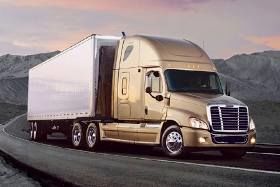Daycab Shifts?
Topic 16827 | Page 1

My company has a mixture of Peterbilts and Freightliners that drivers use as daycabs on the LTL runs. On those LTL runs, some drivers have 520 mile assignments with little or no downtime at the shippers and receivers while other drivers have 200 to 300 mile assignments with extreme amounts of downtime at both the shippers and at the receivers who use a Just In Time Inventory System.
So, I guess the answer to your questions depends on either equipment, miles, or both.
Shipper:
The customer who is shipping the freight. This is where the driver will pick up a load and then deliver it to the receiver or consignee.
LTL:
Less Than Truckload
Refers to carriers that make a lot of smaller pickups and deliveries for multiple customers as opposed to hauling one big load of freight for one customer. This type of hauling is normally done by companies with terminals scattered throughout the country where freight is sorted before being moved on to its destination.
LTL carriers include:
- FedEx Freight
- Con-way
- YRC Freight
- UPS
- Old Dominion
- Estes
- Yellow-Roadway
- ABF Freight
- R+L Carrier
HOS:
Hours Of Service
HOS refers to the logbook hours of service regulations.I generally start my day between 3-4am and will be done anytime between 1-4pm. I do local delivery to grocery stores in the Chicagoland area, 7-11 stops a day.

You're gonna get answers all over the board. Answers will depend on type of freight hauled ( e.g. general goods as in LTL , reefer with food service, car haulers, or fuel with tankers), geographic area, company / terminal specific needs, linehaul vs P&D in the LTL sector or whether you're running containers to the train yards. As others have touched on, there are a variety of trucking jobs that use day cabs.
I've covered all types of runs out of my terminal running linehaul. Our hours vary depending on the mileage / scheduled run. My terminal is a break bulk for the entire northeast, so we have quite a variety of linehaul runs. Currently I do a run that's close to 500 miles every day, takes me about 10.5 hours to complete, and is a daylight run. Because of the area I cover, I don't really run into a lot of traffic.
Terminal:
A facility where trucking companies operate out of, or their "home base" if you will. A lot of major companies have multiple terminals around the country which usually consist of the main office building, a drop lot for trailers, and sometimes a repair shop and wash facilities.
LTL:
Less Than Truckload
Refers to carriers that make a lot of smaller pickups and deliveries for multiple customers as opposed to hauling one big load of freight for one customer. This type of hauling is normally done by companies with terminals scattered throughout the country where freight is sorted before being moved on to its destination.
LTL carriers include:
- FedEx Freight
- Con-way
- YRC Freight
- UPS
- Old Dominion
- Estes
- Yellow-Roadway
- ABF Freight
- R+L Carrier
Day Cab:
A tractor which does not have a sleeper berth attached to it. Normally used for local routes where drivers go home every night.
P&D:
Pickup & Delivery
Local drivers that stay around their area, usually within 100 mile radius of a terminal, picking up and delivering loads.
LTL (Less Than Truckload) carriers for instance will have Linehaul drivers and P&D drivers. The P&D drivers will deliver loads locally from the terminal and pick up loads returning to the terminal. Linehaul drivers will then run truckloads from terminal to terminal.
Linehaul:
Linehaul drivers will normally run loads from terminal to terminal for LTL (Less than Truckload) companies.
LTL (Less Than Truckload) carriers will have Linehaul drivers and P&D drivers. The P&D drivers will deliver loads locally from the terminal and pick up loads returning them to the terminal. Linehaul drivers will then run truckloads from terminal to terminal.Reefer:
A refrigerated trailer.
New Reply:
New! Check out our help videos for a better understanding of our forum features

















Preview:








 TT On Facebook
TT On Facebook
Hey guys, just curious what the daycab guys drive for hours? I've been running a daycab for quite a while now, I was doing 8am till 8pm. I just switched over to 4am to 4pm in hopes that I will get a little more freight. Smart choice? I hate getting home so late especially living in Phoenix, traffic is awful in the morning so I'm hoping the new shift isn't so bad.